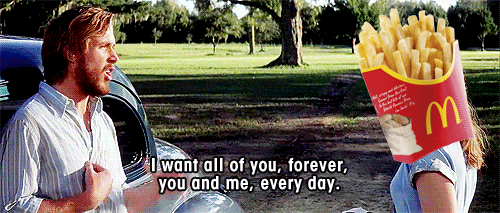Fries, guys!
| source |
 |
| source |
There are 19 ingredients in McDonald’s fries.
 |
| source |
Potatoes, canola oil, soybean oil, hydrogenated soybean oil, natural beef flavour, hydrolyzed wheat, hydrolyzed milk, citric acid, dimethylpolysiloxane, dextrose, sodium acid pyrophosphate, salt, canola oil, corn oil, soybean oil, hydrogenated soybean oil, TBHQ, citric acid, and dimethylpolysiloxane.
Canola, soybean, and hydrogenated soybean oil as well as citric acid and dimethylpolysiloxane are listed twice because they’re used at different stages of production. (source) McDonald’s locations receive their fries frozen where they are then fried in 100% vegetable oil, salted, and dumped into that famous red box. However, I was curious to find out how the fries got to their semi-prepared frozen state.
Until 1967, McDonald’s only purchased fresh potatoes. However, Idaho “potato magnate” J.R. Simplot signed a deal with McDonald’s that year which made them their first frozen french-fry supplier. Since then, Simplot has developed into an international agricultural business.
 |
| source |
However, before potatoes can be cut into fries and frozen, they have to be grown, harvested, and purchased from potato farmers. Farming plays an important role in the commodity chain because it relies on and impacts the world climate, weather, location, etc. Climate change has seen farmers facing negative effects on the success of their crops which ultimately affects their ability to make a livable wage. (source)
One family has been selling potatoes to Simplot for over 50 years. The Noble family has established a solid relationship with McDonald’s which has given them stability in an unpredictable industry. A member of the family, Allen Noble, states “When you deal with somebody for a long time, you know their history, and they know yours,” he told the Statesman. “It’s been very, very good to us.” (source)
This type of close business relationship is reflected in stories of other potato farmers featured on the McDonald’s website. One such farmer, Frank Martinez, explains that he grew up farming with his parents. According to the website, his dad used to tell him, “Behind fear, you will find success.” Martinez found such success and now owns his own farm in Warden, Washington where he produces Russet Burbank potatoes, the “gold standard variety” of potatoes for McDonald’s fries.
Here is a video of his story:
After the potatoes are harvested, they are cleaned, sorted, and then shipped off to processing plants like Simplot. At the plant, potatoes go through a steam peeler. After rinsing the peel off, workers inspect the potatoes for rocks and other debris. After passing inspection, the potatoes are fed through a Lamb Gun Knife at 70mph which gives them their familiar shoestring form. Once cut, the fries are blanched and then dried. Once dry, the fries are partially fried for 45-60 seconds before being sent to the freezer. One final quality inspection separates the fries from finally being packaged and shipped around the world. (source)
Here is a video of Grant Imahara, from Mythbusters, taking a tour of one such factories:
These processing facilities can have a major impact on the environment. One processor, Lamb Weston, has committed to reducing waste by increasing reuse and recycling in their plants. (source)
Other efforts have been to made to reduce the environmental impact. For example, Martin-Brower, a food distributor for McDonald’s, started shipping their products via railway instead of trucks. By doing this, congestion from truck docks was eliminated. Additionally, rail car fuel has a smaller carbon footprint and is more energy efficient. (source)
Other efforts have been to made to reduce the environmental impact. For example, Martin-Brower, a food distributor for McDonald’s, started shipping their products via railway instead of trucks. By doing this, congestion from truck docks was eliminated. Additionally, rail car fuel has a smaller carbon footprint and is more energy efficient. (source)
Now that the potatoes have turned into frozen fries, they are ready to be received by McDonald’s locations where workers will fully fry them and prepare them for consumption.
 |
| source |
Working at McDonald’s impacts the world beyond the products they sell. McDonald’s has committed to providing educational opportunities for their employees through help with attaining a high school diploma, college scholarships, and tuition reimbursement. They also committed to hiring 100,000 veterans by the end of 2015. (source)
It’s easy to neglect the consideration of all of these factors in this commodity chain. For $1.89, you can get a large order of fries without thinking about the potato farmers in Washington or the processing plant CEOs. One doesn’t even have to consider how global relationships affect this process around the world. McDonald’s is synonymous with cheap fast food. However, in Venezuela, that same large order of fries costs 800 bolivars which is roughly $126. (source)
source: tradingeconomics.com
This is due to skyrocketing inflation rates due to a collapsing economy and corrupt government. It is easy to take our food for granted. As Tsing quotes in regards to global commodity chains “both labor and environment are erased in the process of transferring the product to market” (2014:106).
 |
| source |
I really liked how you explained everything. I do not think you left anything out! I definitely understand the addiction to them.
ReplyDelete